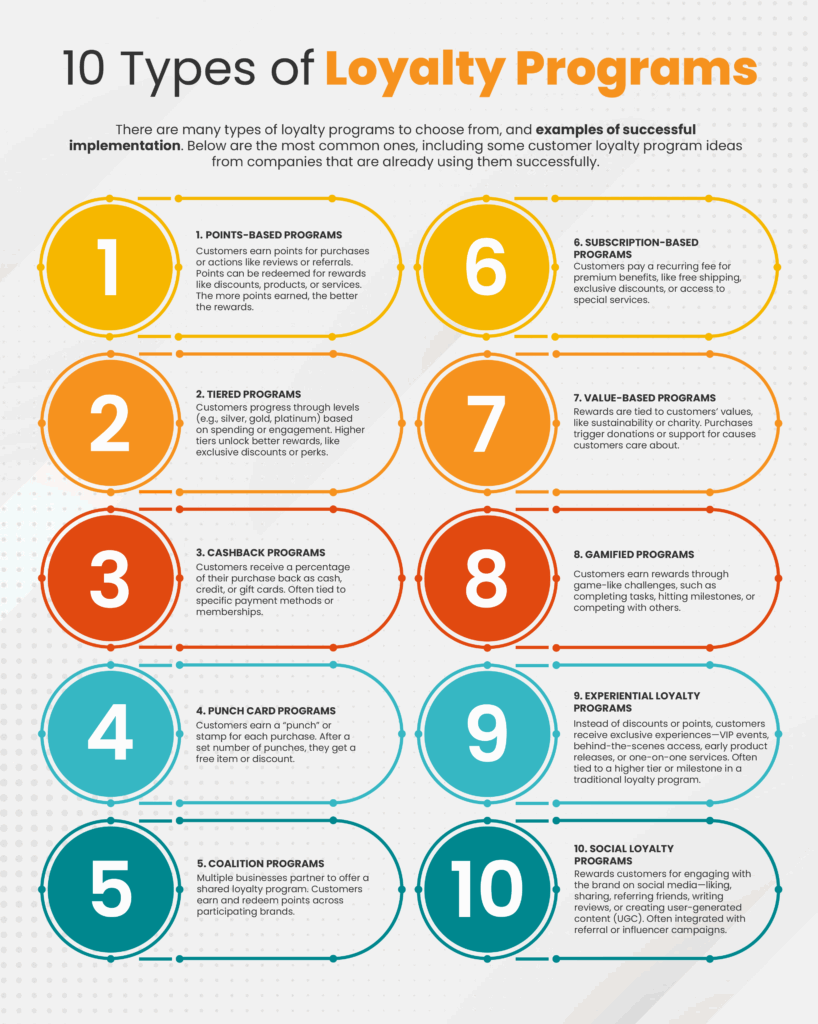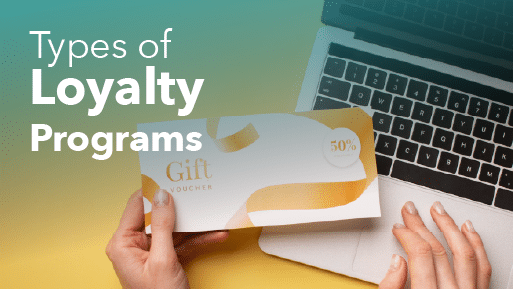Key Takeaways:
- Loyalty programs offer rewards, discounts, or other special incentives designed to encourage customers to purchase a store’s or brand’s products and build trust with them.
- Loyalty programs benefit businesses by building customer loyalty and providing crucial information about customers’ spending and which products or offers are most attractive.
- There are several types of loyalty programs: the most popular are tiered programs, point programs, value-based loyalty programs, and paid loyalty programs.
- The best customer loyalty point programs include Starbucks Rewards, Sephora’s Beauty Insider program, Amazon Prime, and REI’s Co-op Membership program.
Loyalty programs aim to reduce selling costs, build customer profiles for targeted offers, and increase sales. However, there are a lot of them. Knowing which type of loyalty program is best for your brand is essential, so you can effectively leverage it. Below is a guide that walks you through how a loyalty program works and the most common loyalty programs you can offer your customers.
What Is a Retail Customer Loyalty Program?
A retail loyalty program, or a rewards program, is a marketing strategy that rewards customers with unique benefits to encourage them to remain loyal to your store or brand.
Loyalty programs have two purposes: to reward customers for their loyalty and to provide the issuing company with valuable information and data about its consumers.
84% of consumers say they are more likely to remain loyal to a brand that offers a loyalty program. The most effective loyalty programs prioritize enhancing customer retention rates and recognizing and rewarding existing customers.
How Do Customer Loyalty Programs Work?
The operational framework of customer loyalty programs involves several key steps:
- Sign-Up Process: Customers enroll by providing personal information, such as an email address or phone number, and receive a unique identifier. This could be a physical membership card, a numerical ID, or a digital account, often accessed through an app or website.
- Earning Rewards: Customers earn rewards for various actions, primarily purchases, but also non-transactional activities like leaving reviews, referring friends, sharing on social media, or celebrating birthdays. Common rewards include points, discounts, free merchandise, early access to sales, or enhanced services like free or expedited shipping. For instance, in a points-based system, a customer might earn one point per dollar spent, redeemable for a discount after reaching a threshold.
- Redemption Process: Earned rewards can be redeemed for free products, cash back, or exclusive perks. Redemption is often facilitated through the same platform used for earning, ensuring convenience.
- Tiered Structures: Many programs implement tiered systems where customers progress to higher levels based on spending or engagement, unlocking better rewards.
- Personalization and Engagement: Modern loyalty programs leverage data analytics to personalize offers, tailoring rewards to individual preferences. For instance, customers who frequently buy coffee might receive a personalized discount on their favorite drink. Engagement extends beyond purchases, with rewards for actions like app logins or social media shares, fostering a deeper connection.
- Data Collection and Utilization: By participating, customers provide data on their spending habits, preferences, and behaviors, which businesses analyze to improve marketing strategies, product offerings, and customer experiences.
Benefits of Retail Loyalty Programs
Retail loyalty programs drive customer retention, boost repeat purchases, and increase average order values through personalized rewards. They foster emotional connections, turning one-time buyers into advocates, and provide retailers with valuable data for targeted marketing and inventory optimization.
Benefit #1: Increases Customer Lifetime Value (CLV)
Loyalty programs incentivize repeat purchases and higher spending per visit (Average Order Value or AOV). Since it costs significantly less to retain an existing customer than to acquire a new one, this combination directly boosts the overall CLV and profitability for the retailer.
Benefit #2: Provides Valuable Customer Data
A loyalty program is a powerful data engine that captures first-party information on customer preferences, purchase frequency, and spending habits. This allows retailers to move past generic offers and execute highly effective, personalized marketing strategies that resonate with individual shoppers.
Benefit #3: Cultivates Brand Advocates and Referrals
By rewarding customers for more than just purchases (like referrals or social sharing), retailers transform loyal members into brand advocates. This positive word-of-mouth marketing is highly trusted and acts as a powerful, low-cost customer acquisition tool that drives new sales.
Benefit #4: Enhanced Customer Experience and Retention
Loyalty schemes foster a stronger emotional connection by providing members with exclusive perks, early access, and personalized recognition. Effective retail point of sale solutions, like KORONA POS, help retailers succeed by integrating a simple point-based loyalty program and customer relationship management (CRM) tools to manage these experiences seamlessly. You can see a related breakdown here: how loyalty and membership programs increase amusement park revenue.
Speak with a product specialist and learn how KORONA POS can power your business.
10 Types of Loyalty Programs

There are many types of loyalty programs to choose from, and examples of successful implementation. Below are the most common ones, including some customer loyalty program ideas from companies that are already using them successfully.
1. Points-Based Programs
How it works
Customers earn points for purchases or actions like reviews or referrals. Points can be redeemed for rewards like discounts, products, or services. The more points earned, the better the rewards.
Who it’s ideal for
Businesses with frequent customer purchases, such as retail, coffee shops, or e-commerce. Suits customers who enjoy tracking progress toward rewards.
Pros and cons
- Pros:
- Easy to understand and implement.
- Encourages repeat purchases.
- Flexible reward options.
- Cons:
- Can feel generic if not personalized.
- Points may expire, frustrating customers.
- High redemption thresholds may deter engagement.
Examples
- Starbucks Rewards: Earn stars for purchases, redeem for drinks or food.
- Sephora Beauty Insider: Points for purchases, redeem for products or experiences.
- Amazon Prime: Points through specific actions, redeem for discounts.
2. Tiered Programs
How it works
Customers progress through levels (e.g., silver, gold, platinum) based on spending or engagement. Higher tiers unlock better rewards, like exclusive discounts or perks.
Who it’s ideal for
Businesses with varied customer spending levels, like airlines, hotels, or luxury brands. Appeals to customers motivated by status and exclusivity.
Pros and cons
- Pros:
- Encourages higher spending to reach top tiers.
- Creates a sense of exclusivity.
- Rewards loyal customers with premium perks.
- Cons:
- Complex to manage multiple tiers.
- Lower tiers may feel neglected.
- High maintenance costs for premium rewards.
Examples
- American Airlines AAdvantage: Earn miles for flights, higher tiers get upgrades and lounge access.
- Marriott Bonvoy: Points-based tiers with benefits like free nights or elite status.
- Ulta Beauty Ultamate Rewards: Tiered benefits with exclusive events for top spenders.
3. Cashback Programs
How it works
Customers receive a percentage of their purchases as cash, credit, or gift cards. Often tied to specific payment methods or memberships.
Who it’s ideal for
Retail, grocery stores, or credit card companies. Suits customers who prefer immediate, tangible rewards over points.
Pros and cons
- Pros:
- Simple and transparent.
- Appeals to cost-conscious customers.
- Encourages repeat purchases.
- Cons:
- Less engaging than points or tiers.
- Can be costly for businesses.
- Limited differentiation from competitors.
Examples
- Discover Card Cashback: Earn cashback on purchases, redeem as a statement credit.
- Target Circle: Cashback rewards applied to future purchases.
- Rakuten: Cashback for shopping through their platform.
4. Punch Card Programs
How it works
Customers earn a “punch” or stamp for each purchase. After a set number of punches, they get a free item or discount.
Who it’s ideal for
Small businesses like cafes, bakeries, or car washes. Best for customers who make frequent, low-cost purchases.
Pros and cons
- Pros:
- Low-cost and straightforward to implement.
- Encourages repeat visits.
- Works well for small transactions.
- Cons:
- Limited scalability for large businesses.
- Easy to lose physical cards.
- Less engaging for high-value purchases.
Examples
- Local coffee shops: Buy 10 coffees, get one free.
- Car wash loyalty cards: Wash 5 times, get a free wash.
- Smoothie King: Punch for each smoothie, redeem after 10.
5. Coalition Programs
How it works
Multiple businesses partner to offer a shared loyalty program. Customers earn and redeem points across participating brands.
Who it’s ideal for
Businesses in complementary industries, like travel or retail coalitions. Suits customers who shop across multiple brands.
Pros and cons
- Pros:
- Expands customer reach across brands.
- Increases reward flexibility.
- Enhances customer convenience.
- Cons:
- Complex to coordinate with partners.
- Shared data raises privacy concerns.
- Dilutes individual brand loyalty.
Examples
- Air Miles: Earn miles at various retailers and redeem them for travel or goods.
- Plenti (discontinued): Points earned across partnered brands like Macy’s and Exxon.
- Nectar (UK): Points collected at Sainsbury’s, eBay, etc.
6. Subscription-Based Programs
How it works
Customers pay a recurring fee for premium benefits, like free shipping, exclusive discounts, or access to special services.
Who it’s ideal for
E-commerce, streaming services, or businesses with consistent customer needs. Appeals to customers who value convenience and exclusivity.
Pros and cons
- Pros:
- Predictable revenue for businesses.
- Enhances customer retention.
- Premium perks create loyalty.
- Cons:
- Upfront cost may deter customers.
- Must continually justify subscription value.
- Risk of customer churn if benefits underwhelm.
Examples
- Amazon Prime: Free shipping, streaming, and exclusive deals for a yearly fee.
- Walmart+: Free shipping and discounts for a monthly subscription.
- Spotify Premium: Ad-free music and offline access for a monthly fee.
7. Value-Based Programs
How it works
Rewards are tied to customers’ values, like sustainability or charity. Purchases trigger donations or support for causes customers care about.
Who it’s ideal for
Brands with socially conscious customers, like eco-friendly or nonprofit-aligned businesses. Suits customers who prioritize ethics.
Pros and cons
- Pros:
- Builds emotional connection with customers.
- Differentiates brand in competitive markets.
- Appeals to younger, value-driven audiences.
- Cons:
- Harder to measure ROI.
- May alienate customers with differing values.
- Requires authentic commitment to causes.
Examples
- TOMS One for One: Buy a pair of shoes, donate a pair to someone in need.
- Patagonia: Purchases support environmental initiatives.
- Bombas: Buy socks, donate a pair to homeless shelters.
8. Gamified Programs
How it works
Customers earn rewards through game-like challenges, such as completing tasks, hitting milestones, or competing with others.
Who it’s ideal for
Brands targeting younger, tech-savvy audiences, like fitness apps or mobile games. Suits customers who enjoy interactive experiences.
Pros and cons
- Pros:
- Highly engaging and fun.
- Encourages frequent interaction.
- Appeals to competitive customers.
- Cons:
- Complex to design and maintain.
- May not suit all demographics.
- High development costs.
Examples
- Nike Run Club: Earn badges for running milestones.
- Duolingo: Points and streaks for language lessons.
- MyFitnessPal: Challenges for fitness goals with rewards.
9. Experiential Loyalty Programs
How it works
Instead of discounts or points, customers receive exclusive experiences—VIP events, behind-the-scenes access, early product releases, or one-on-one services. Often tied to a higher tier or milestone in a traditional loyalty program.
Who it’s ideal for
Luxury, travel, and lifestyle brands that want to deepen emotional connections and offer exclusive access rather than discounts.
Pros and cons
Pros:
- Builds strong emotional loyalty.
- Differentiates brand with memorable perks.
- Appeals to affluent or experience-driven consumers.
Cons:
- Not scalable for all customers.
- Higher operational costs.
- May not offer tangible value to every customer.
Examples:
- American Express Platinum: Offers airport lounge access, concierge services, and invites to exclusive events.
- Starbucks Reserve: Offers exclusive tastings and access to high-end cafes.
10. Social Loyalty Programs
How it works
Rewards customers for engaging with the brand on social media—liking, sharing, referring friends, writing reviews, or creating user-generated content (UGC). Often integrated with referral or influencer campaigns.
Who it’s ideal for
E-commerce, lifestyle, and fashion brands looking to grow through organic social reach and peer influence.
Pros and cons
Pros:
- Amplifies brand visibility and awareness.
- Encourages referrals and UGC.
- Cost-effective marketing channel.
Cons:
- Can be hard to track or verify authenticity.
- Rewards might attract low-quality engagement.
- Needs an active social media presence to succeed.
Examples:
- Glossier: Offers store credit for friend referrals and UGC on Instagram.
- Dropbox: Grew rapidly by giving free storage space for referrals and shares.
Top Retail Customer Loyalty Programs
Discover the top customer loyalty programs in retail that drive engagement and retention. From Starbucks to Sephora, these programs leverage points, tiers, and personalized perks to foster loyalty, boost sales, and provide valuable data insights, setting benchmarks for success across industries.
Program #1: Starbucks Rewards
Overview:
Starbucks Rewards is the coffee industry’s leading loyalty program, designed to reward customers for their habits and grow Starbucks’ digital ecosystem. Members earn points—called Stars—on purchases redeemable for free drinks, food, and member incentives.
How It Works:
Members earn 2 Stars per $1 spent (using the app or Starbucks card). Two membership tiers—Green and Gold—offer progressive benefits; Gold requires a higher annual spend to unlock premium perks. Stars can be redeemed for drinks, food items, and other rewards.
Key Features:
- Mobile app for payments, ordering, and managing rewards
- Free birthday reward
- Personalized offers and challenges
- Bonus star opportunities
- Click & collect ordering
Benefits for Customers:
Customers love its user-friendly app, fast rewards, exclusive offers, and personalized experiences tailored to their preferences. Gamified challenges add enjoyment to everyday purchases.
Benefits for Retailers:
Starbucks uses customer data for insights, driving retention, larger average orders, and menu exploration. Digital engagement helps boost mobile order and pay adoption—all enhancing customer lifetime value.
Who It’s Best For:
Ideal for brands with frequent, habitual purchase patterns (café, quick service, convenience retail).
Notable Stats:
As of 2024, Starbucks Rewards surpassed 75 million global members, accounting for more than half of U.S. sales.
Program #2: Sephora Beauty Insider
Overview:
Sephora Beauty Insider is an iconic tiered loyalty program in beauty retail, rewarding shoppers with points per dollar spent and incentivizing deeper engagement.
How It Works:
Free to join, members earn 1 point per $1, redeemable for products, discounts, or unique experiences. Three loyalty tiers—Insider, VIB, and Rouge—unlock escalating perks based on annual spend.
Key Features:
- Instant cashback ($10 off for 500 points)
- Free birthday gift
- First access to new launches
- Beauty classes and exclusive events
Benefits for Customers:
The program offers ultimate choice in rewards and personalized experiences—from product samples to exclusive meet-and-greets.
Benefits for Retailers:
Sephora gains data-driven insights, deepens brand loyalty, and inspires higher purchase frequency through experiential perks.
Notable Stats:
Beauty Insider boasts 34+ million active members, making it a benchmark for multi-tier retail programs.
Program #3: H&M Membership
Overview:
H&M’s Membership program gamifies fashion shopping with a flexible, app-driven points system that rewards sustainable behavior and regular purchases.
How It Works:
Earn 1 point per $1 spent—200 points yield a $5 reward coupon. Two tiers (Core, Plus) offer growing benefits, with points also earned for recycling clothes and engaging in challenges.
Key Features:
- 10% welcome discount
- Birthday coupon (25% off one item)
- Exclusive events, early access, and surprise offers
- Points for recycling and eco actions
Benefits for Customers:
Shoppers value the ease of earning, birthday rewards, digital receipts, and free shipping/returns at higher tiers.
Benefits for Retailers:
Facilitates omnichannel engagement, advances sustainability objectives, and encourages data collection for personalized targeting.
Notable Stats:
Over 200 million global members, among the world’s largest retail loyalty communities.
Program #4: adidas adiClub
Overview:
adiClub turns every interaction into a reward—points are earned from purchases, workouts, product reviews, or events, elevating the brand’s sports and style communities.
How It Works:
Membership is free, offering four tiers (Levels 1–4). Progress by earning points: shop, write reviews, or log workouts. Higher levels unlock early access to launches, exclusive drops, event invites, and even digital subscriptions.
Key Features:
- Points for purchases and activity
- Exclusive sneaker drops
- Access to premium fitness and entertainment partners
- Personalization features
Benefits for Customers:
Fans love the breadth of rewards—sneakers, experiences, subscriptions, and brand community perks.
Benefits for Retailers:
Deepens engagement by incentivizing multiple customer actions, expanding direct-to-consumer channels.
Notable Stats:
adiClub is lauded as one of the top global loyalty programs for both customer engagement and member value.
Program #5: Chipotle Rewards
Overview:
Chipotle Rewards encourages fast-casual loyalty by giving customers points with every purchase, expanding personalized experiences beyond food.
How It Works:
Earn 10 points per $1 spent; redeem 1,250 points for a free entree. Built-in gamification (badges, challenges) and personalized communication increase member involvement.
Key Features:
- Points for every purchase
- Gamified achievements
- App-based ordering
- Exclusive digital offers and free birthday treats
Benefits for Customers:
Fast, valuable rewards and app convenience are highly appreciated, including flexible redemption options.
Benefits for Retailers:
Drives digital sales, leverages CRM for targeted messaging, and enhances customer frequency and retention.
Notable Stats:
Chipotle Rewards now exceeds 27 million members, helping drive a major shift to digital sales channels
Make Loyalty Program Integration Easy With KORONA POS
Small retail businesses often find integrating a loyalty program daunting, but KORONA POS makes the process seamless and intuitive.
Whether you’re implementing a points-based system, punch card rewards, or tiered loyalty levels, KORONA’s cloud-based POS platform allows you to configure and manage programs directly from your dashboard—no third-party plugins or complicated setups required.
Real-time tracking, customer segmentation, and automated rewards ensure that your loyalty program runs smoothly and effectively. KORONA POS is an all-in-one solution that helps you market your products with your point of sale.
Best of all, the system adapts as your business grows, allowing you to scale your rewards program over time. Ready to simplify customer retention? Click below to sign up for a demo with KORONA POS today.
Speak with a product specialist and learn how KORONA POS can power your business.
FAQs
What are the 3 R’s of a customer loyalty program?
The three R’s of a customer loyalty program are Reward, Recognition, and Relevance. Rewards give customers incentives like discounts or points for purchases. Recognition makes customers feel valued through personalized offers or exclusive perks. Relevance ensures the program aligns with customer needs and preferences.
What is another name for a loyalty program?
A loyalty program is also known as a rewards program. Other terms include customer retention programs or membership programs.
How much does it cost to launch a loyalty program?
The cost to launch a loyalty program varies widely. Small businesses might spend $1,000-$5,000 on basic software and setup. Larger companies could invest $50,000-$500,000 for custom platforms, marketing, and integration. Costs depend on program complexity, technology, and scale. Check platforms like x.ai for potential API solutions to streamline development.












